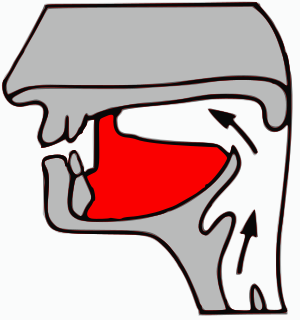Fricatives are consonants produced by forcing air through a narrow channel made by placing two articulators close together. These may be the lower lip against the upper teeth, in the case of ; the back of the tongue against the soft palate, in the case of German ; or the side of the tongue against the molars, in the case of Welsh. This turbulent airflow is called frication.
An affricate is a consonant that begins as a stop and releases as a fricative, generally with the same place of articulation. It is often difficult to decide if a stop and fricative form a single phoneme or a consonant pair. English has two affricate phonemes, and, often spelled ch and j, respectively.
Sibilants are fricative consonants of higher amplitude and pitch, made by directing a stream of air with the tongue towards the teeth. Examples of sibilants are the consonants at the beginning of the English words sip, zip, ship, and genre. The symbols in the International Phonetic Alphabet used to denote the sibilant sounds in these words are, respectively,. Sibilants have a characteristically intense sound, which accounts for their paralinguistic use in getting one's attention.
Labialization is a secondary articulatory feature of sounds in some languages. Labialized sounds involve the lips while the remainder of the oral cavity produces another sound. The term is normally restricted to consonants. When vowels involve the lips, they are called rounded.
In phonetics, ejective consonants are usually voiceless consonants that are pronounced with a glottalic egressive airstream. In the phonology of a particular language, ejectives may contrast with aspirated, voiced and tenuis consonants. Some languages have glottalized sonorants with creaky voice that pattern with ejectives phonologically, and other languages have ejectives that pattern with implosives, which has led to phonologists positing a phonological class of glottalic consonants, which includes ejectives.
Postalveolar or post-alveolar consonants are consonants articulated with the tongue near or touching the back of the alveolar ridge. Articulation is farther back in the mouth than the alveolar consonants, which are at the ridge itself, but not as far back as the hard palate, the place of articulation for palatal consonants. Examples of postalveolar consonants are the English palato-alveolar consonants, as in the words "ship", "'chill", "vision", and "jump", respectively.

A retroflex, apico-domal, or cacuminalconsonant is a coronal consonant where the tongue has a flat, concave, or even curled shape, and is articulated between the alveolar ridge and the hard palate. They are sometimes referred to as cerebral consonants—especially in Indology.
A voiced postalveolar fricative is a type of consonantal sound used in some spoken languages. This refers to a class of sounds, not a single sound. There are several types with significant perceptual differences:

The voiceless alveolo-palatal sibilant fricative is a type of consonantal sound, used in some spoken languages. The symbol in the International Phonetic Alphabet that represents this sound is ⟨ɕ⟩. It is the sibilant equivalent of the voiceless palatal fricative, and as such it can be transcribed in IPA with ⟨ç˖⟩.
A voiceless postalveolar fricative is a type of consonantal sound used in some spoken languages. This refers to a class of sounds, not a single sound. There are several types with significant perceptual differences:

In phonetics, alveolo-palatal consonants, sometimes synonymous with pre-palatal consonants, are intermediate in articulation between the coronal and dorsal consonants, or which have simultaneous alveolar and palatal articulation. In the official IPA chart, alveolo-palatals would appear between the retroflex and palatal consonants but for "lack of space". Ladefoged and Maddieson characterize the alveolo-palatals as palatalized postalveolars (palato-alveolars), articulated with the blade of the tongue behind the alveolar ridge and the body of the tongue raised toward the palate, whereas Esling describes them as advanced palatals (pre-palatals), the furthest front of the dorsal consonants, articulated with the body of the tongue approaching the alveolar ridge. These descriptions are essentially equivalent, since the contact includes both the blade and body of the tongue. They are front enough that the fricatives and affricates are sibilants, the only sibilants among the dorsal consonants.

An apical consonant is a phone produced by obstructing the air passage with the tip of the tongue (apex) in conjunction with upper articulators from lips to postalveolar, and possibly prepalatal. It contrasts with laminal consonants, which are produced by creating an obstruction with the blade of the tongue, just behind the tip. Sometimes apical is used exclusively for an articulation that involves only the tip of the tongue and apicolaminal for an articulation that involves both the tip and the blade of the tongue. However, the distinction is not always made and the latter one may be called simply apical, especially when describing an apical dental articulation. As there is some laminal contact in the alveolar region, the apicolaminal dental consonants are also labelled as denti-alveolar.

The voiceless palato-alveolar sibilant affricate or voiceless domed postalveolar sibilant affricate is a type of consonantal sound used in some spoken languages. The sound is transcribed in the International Phonetic Alphabet with ⟨t͡ʃ⟩, ⟨t͜ʃ⟩ or ⟨tʃ⟩. The alternative commonly used in American tradition is ⟨č⟩. It is familiar to English speakers as the "ch" sound in "chip".

The voiced palato-alveolar sibilant affricate, voiced post-alveolar affricate or voiced domed postalveolar sibilant affricate, is a type of consonantal sound, used in some spoken languages. The sound is transcribed in the International Phonetic Alphabet with ⟨d͡ʒ⟩, or in some broad transcriptions ⟨ɟ⟩, and the equivalent X-SAMPA representation is dZ. Alternatives commonly used in linguistic works, particularly in older or American literature, are ⟨ǰ⟩, ⟨ǧ⟩, ⟨ǯ⟩, and ⟨dž⟩. It is familiar to English speakers as the pronunciation of ⟨j⟩ in jump.
The palato-alveolar ejective affricate is a type of consonantal sound, used in some spoken languages. The sound is represented in the International Phonetic Alphabet with ⟨t͡ʃʼ⟩. In some languages it is equivalent to a palatal ejective.

The voiceless retroflex sibilant affricate is a type of consonantal sound, used in some spoken languages. The symbol in the International Phonetic Alphabet that represents this sound is ⟨ʈ͡ʂ⟩, sometimes simplified to ⟨tʂ⟩ or ⟨ꭧ⟩, and the equivalent X-SAMPA symbol is ⟨ts`⟩.

In linguistics, specifically articulatory phonetics, tongue shape describes the shape that the tongue assumes when it makes a sound. Because the sibilant sounds have such a high perceptual prominence, tongue shape is particularly important; small changes in tongue shape are easily audible and can be used to produce different speech sounds, even within a given language.
Palatalization is a historical-linguistic sound change that results in a palatalized articulation of a consonant or, in certain cases, a front vowel. Palatalization involves change in the place or manner of articulation of consonants, or the fronting or raising of vowels. In some cases, palatalization involves assimilation or lenition.







